Check out our in-depth look at how businesses utilise social media communities, why they work so well and how they can help to grow your brand online.
Social media communities can be broadly categorised into two types: structured platforms like pages, groups, or sites where brand enthusiasts actively participate, and an informal yet vibrant follower base that engages deeply with your organic content. This article will primarily delve into the structured format, particularly Facebook groups, as they offer actionable insights for enhancing brand equity. However, we will also explore the dynamics of the less-defined yet influential informal social media communities.
Informal social media communities
Online fashion retailers are leaders in building dedicated, but informal, social media communities. Key elements of their strategies include sharing user-generated content, hosting giveaways and performing attentive community management. ASOS and Nasty Gal both have huge informal social media communities. As you can see below, they’ve achieved this by cultivating meaningful relationships with their followers. The most impactful interactions with followers tend to be sharing their content, responding to comments – positive, negative or challenging – and creating ‘tag a friend’ giveaway opportunities. As a result, their followers evolve into a community of fans waiting to see what content is shared or how they can engage next.
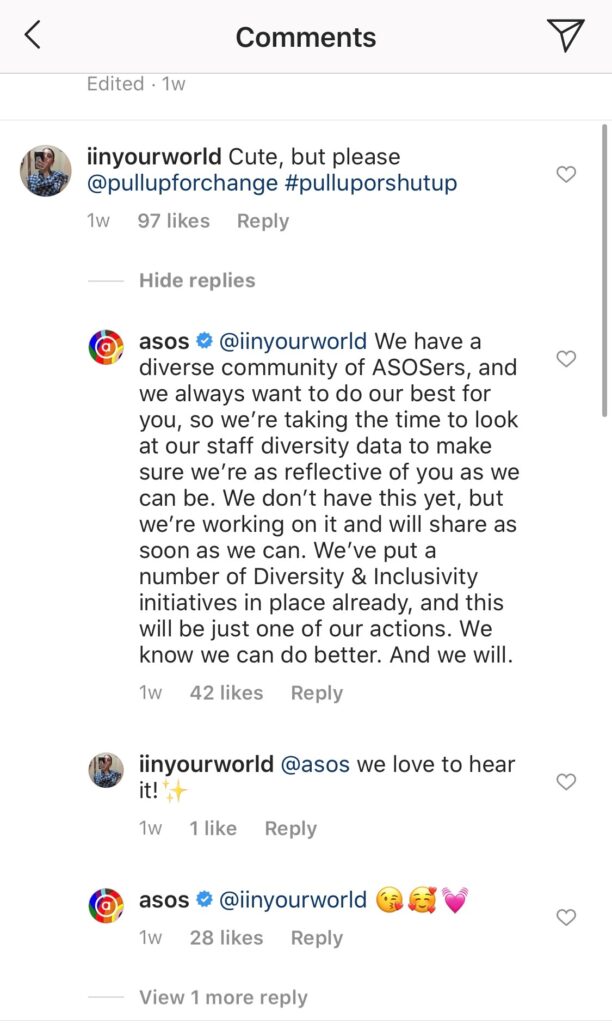
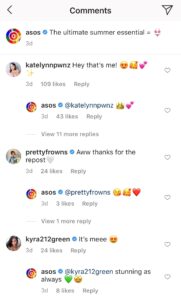
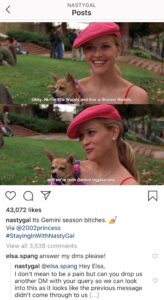
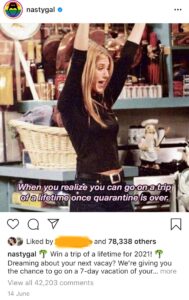
There are plenty of excellent examples of brands that do this well. But it’s also really easy to get it wrong. To learn which community management mistakes will alienate your audience click here to read our specialised Giraffe Guide.
Why isn’t a Facebook page enough?
With the motive of making Facebook more community-focused, the platform has in recent years made several updates which have completely changed the way businesses should be sharing content. Algorithm updates to the platform mean that the content your page shares is less likely to show up in your follower’s timelines. Consider your own feed. How often do you see an unsponsored business page pop up? In the interest of authenticity, Facebook shows users more of their friend’s dog or brunch pics, than brand content like yours.
To succeed organically on Facebook, you can’t only post on your page and hope for the best, in many cases, it’s the digital equivalent of screaming into the void. Of course, that’s where ads come in. You can promote your content to ensure it reaches your followers and beyond. But if you don’t have a sizeable social advertising budget, you’re going to need to consider the value of social media communities. Facebook reports that there are tens of millions of active Groups on Facebook and more than 400 million users that belong to a Group.
The benefits of Facebook groups
It’s not all bad news. To make up for the new challenges for businesses, in 2017, Facebook launched its “Groups for Pages” initiative. This update allowed brands to create or link dedicated groups to their business pages and so begin fostering communities and building more meaningful – and potentially profitable – engagement around their brand activity.
The group function now also allows you to get to know your core customers better than ever before, with their improved “Insight” tabs. The “Membership” tab lets you see who your top contributors are, visit their profiles and look for common interests to help flesh out what your customers really look like and care about. A visual representation of their ages, genders and geographic locations in terms of countries, cities and towns is also offered.
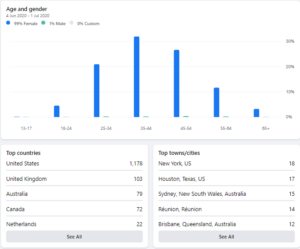
On top of the usual engagement metrics available to page-users, brands can now see the most popular days and times for activity within their group. This sort of data is usually only available through paid-for third-party software. But with a Facebook group, you can discover when your members are most active for free and can tailor your content to suit them.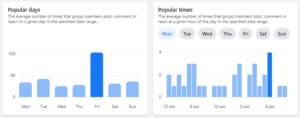
These detailed insight offerings are gold mines which you can mimic when creating content and audiences for your organic Facebook page content or social advertising campaigns. Plus, all the analytical reports are downloadable. Which proves that Facebook groups are a great example of how social media communities don’t just work well in isolation; but can enhance your overall marketing efforts.
Pyramid Scheme social media communities
Many self-employed individuals or small-scale franchise owners have been using Facebook groups as the backbone of their marketing strategy for years. Pyramid models lend themselves well to community building as they tend to start with a person’s authentic personal circle. An individual might begin sharing products with family. Then those family members might tell their friends, who tell their own family, and so on. It’s easy to see how this once door-to-door or in-person process can accelerate in the highly sharable culture of social media. Independent Body Shop consultants are a particularly good example.
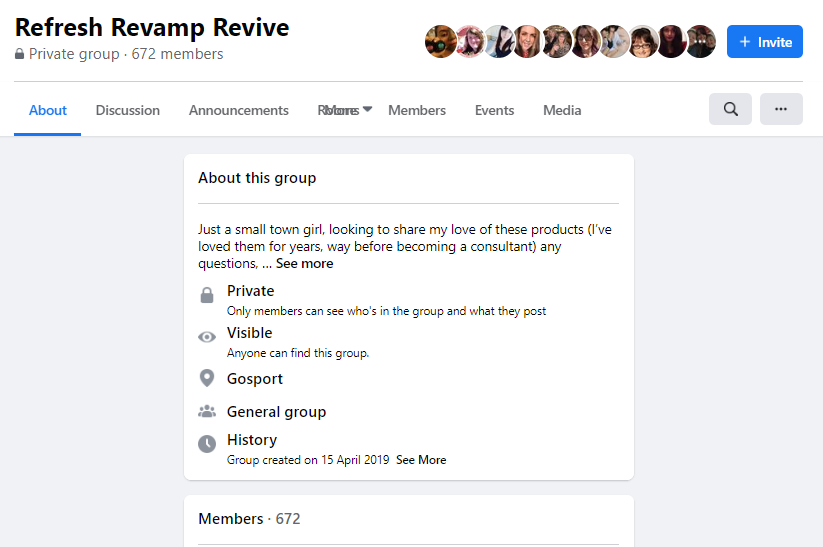
When consultant Aimie Osbourne first started her Body Shop Facebook group, “Refresh Revamp Revive”, she remembers getting “excited because I had 22 members”. The group has now organically grown to have over 600 members, several of whom have gone on to join Aimie’s team as consultants themselves.
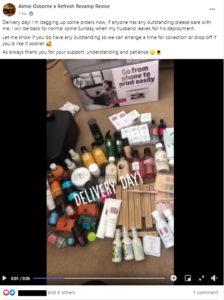
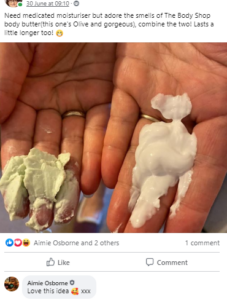
When asked about why her group works so well, she told us that it’s because:
“I’m not pushing things onto people, a lot of them have chosen to be there – and I’m forever grateful for that. I think being open and honest with your customer base builds good rapport. After all, they could shop The Body Shop products online or in-store, but a lot of them choose to do it through me because I give them a unique customer service experience that they can’t get elsewhere and I’m very honest. It’s a safe place for most people, and I’m so proud of how far I have come.”
The power of authentic personal recommendations and service, which Aimie highlights above, is the core element of successful social media communities. Want the good news? It’s incredibly scalable and translates to almost any industry.
Peloton
It would be impossible to discuss brands who are successfully growing social media communities without mentioning Peloton. Peloton is a highly successful American exercise equipment and media company. Their signature static bikes come equipped with touch screens that offer personalised metrics, online classes, competitive leader boards and other social elements. But their social connectivity extends far beyond their screens. Peloton owners or admirers also now have the option to join a range of official Facebook groups. User-generated content within the groups varies from personal challenge celebrations to product reviews to friendly encouragement shared between newfound ‘Pelo-pals’.
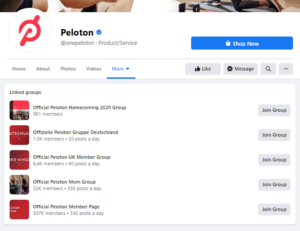
It didn’t take long for health-conscious users to start flocking to Peloton’s social media communities. The company’s VP of community, Jayvee Nava, has been quoted saying that Group membership numbers grew from 1,300 in 2015 to more than 116,000 by 2018. And they now have almost triple that amount. “Membership growth in the Group has far outpaced Bike sales, as existing Members invite their family, friends and colleagues to join this positive and supportive community,” said Nava.
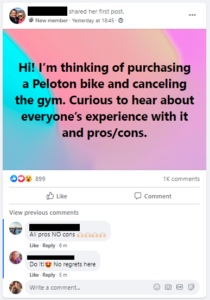
The above is just one of over 500 posts a day to the “Official Peloton Member Page”. Can you imagine being able to present an enquiring customer with over a thousand authentic, positive reviews and recommendations, in less than 24 hours? Peloton is a brilliant example of how brands can use social media communities as both aspirational lifestyle platforms and highly successful routes to market.
The Debenhams evolution
Debenhams is the UK’s online market leader in sales of premium beauty and makeup products. Alongside their Beauty Club loyalty card initiative, which has over a million members, they host an online Beauty Community for their customers. This online hub gives devoted beauty-lovers and Debenhams fans a place to gather, chat and recommend products. It also creates a brilliant captive-audience for Debenhams’ marketing initiatives and campaigns.

Like so many others, the Beauty Community began with a simple Facebook group. Group members and brand fans could join the group to discuss their favourite products and interact directly with beauty influencers and members of the business’s central marketing team. As a result of the groups’ success and to capitalise on the widely used loyalty scheme, Debenhams successfully launched the UK’s first “loyalty-based digital social platform” in 2018. They successfully made the transition to the standalone website by inviting the group’s most active members to announce the move. They also made use of extensive macro-influencer marketing and hosted a variety of high-value giveaways.
Debenhams were clearly aware of the lucrative rewards that active social media communities can reap as they invested heavily in the new Lithium-hosted platform. They weren’t wrong. In the first year, the Beauty Community received over 1.7 million unique visitors. Interestingly, the retailer has also reported that Club Members typically spend three times more on beauty than other Debenhams customers.
How has social media impacted in-store design?
Debenhams’ director of creative, Mark Stevens, told attendees at last year’s London Future Stores event how the Beauty Community has gone on to influence in-store merchandising. “If someone recommended a product, we can put the specific review [in the store]. It’s not just five stars, it’s personal to the person who has written the review, and they go on to our creative fixtures around the stores”. This move, he explained, was by inspired by the understanding that customers are “seeking authentic recommendations” and are “driven by reviews over advertising”.
Why are social media communities so successful?
Social media communities and groups are effective because they offer users the essence of what social media is designed for: connection. Users can find other, like-minded individuals who want to discuss the same things they do. From puppies to monster trucks, there’s a group for everyone and everything. Of course, the benefits for businesses like yours occur when those things happen to be the products you sell.
How do communities help sales?
The reason for the maximised selling power within a community as opposed to, say, your public business page, is the power of the personal recommendation. Of course, customer testimonials are useful and worth including in your main page’s content strategy. Still, there can be an element of disconnect when that testimonial seems like it’s been cherry-picked or manipulated by the brand. After all, what company is going to showcase its bad reviews? But when a customer posts a positive review directly to a group, they are speaking as a real person, sharing real opinions. The capacity for users to share negative reviews or comments, allows positive reviews to seem that much more genuine and meaningful.
In a sense, every active member of an organised community becomes a micro-influencer, with the power to positively or negatively impact other members with their authentic reviews and opinions. If you’re worried the comments will be negative, try not to. A factor in your favour is that members of formal groups or platforms are already interested in your brand. Having gone to the effort of joining, they are more likely to exhibit positive brand sentiment and recommend your products or service. The worst that can happen is someone posts a genuine complaint, but as an active moderator and participant, you have an excellent opportunity to communicate and resolve that complaint positively.
How do social media communities impact your sales funnel?
From a more technical marketing standpoint, social media communities can form a kind of digital net at the bottom of your sales funnel. By joining your group, a user moves past the early awareness stage and progresses to considering your offering with potential intent to buy. This process will naturally be sped up as they receive notifications about the steady stream of content from both you and your group members.
If a group member makes a purchase, they are likely to want to share it with the rest of the group as it gives them another way to engage with other members. This provides an effective fast-track from the funnel’s purchase stage to levels of brand loyalty and advocacy, made all the more effective by the public setting, with its captive and already-interested audience.
Provided you have a high-quality and varied brand offering, there’s no real reason for a user to leave your community. Effectively retaining them as long-term brand advocates and potential repeat customers.
Is building a formal social media community right for your business?
If you are confident in your product and offering, and there’s a key interest that unites your customers, then the answer is yes. If you’re active on social media, then you potentially already have some degree of an informal brand community. You just need to give them a place to connect.
Discovering a collective interest to unify your customers is probably more straightforward than you think. Consider the main pain points that bring your customers to you and what they love. If you sell floppy hats, create a floppy hat appreciation society. If you are a local commercial real estate agent, you could create a “Small Businesses of the South Coast” forum where your customers can share concerns.
Don’t forget that the members of your group or social media community aren’t necessarily already your customers or clients. It’s important not to exclude anyone by limiting the group to, for example, “Orange Car Owners”. You could potentially attract more members with the more inclusive and aspirational, “Orange Car Fans”.
How do I build my own social media community?
Once you’ve thought about what the focus of the group will be and thought of a name, it’s time to set up your own social media community! If your customers are Facebook users, then adding a group to your business page is the best place to start. We’ve created a handy, step-by-step guide on how to do just that, which you can view by clicking here.
Most people (over 2.6 billion) have a Facebook page, whether or not Facebook is their preferred platform. Facebook’s group format is already so user and administrator-friendly. It’s worth establishing your community there and directing your customers or followers from other platforms to join.
What kind of content should I post in my group?
While the topic of every group’s posts will vary, their primary, unifying function should not. Here are some post concepts that your group should be covering:
- Relevant talking points – Start conversations with your members by asking them questions about their interests, lives and aspirations.
- Uplifting content – Give your members a reason to feel good. From #mondaymotivation quotes to customer success stories or good news posts. It’s up to you to establish a positive tone for your group’s atmosphere.
- Personal content – Groups break down the barriers between brand and consumer. Take advantage of the more sheltered setting by offering deeper insights into company life and your team’s own opinions.
- Exclusive offerings – Whether that’s a sneak peek at an upcoming release, a giveaway or a special discount code. These users are your brand’s biggest fans. You should reward them.
- Product/sales posts – These are at the bottom for a reason. While they are, of course, crucial to mention regularly, frequent sales-focused posts are likely to disillusion social media communities. Remember, they’ve joined because they want to connect, not just to fulfil your monthly sales targets (although hopefully, they’ll eventually do that too).
This is by no means a complete list. As your membership grows, you’ll be able to use the detailed engagement metrics available to figure out what content works best. The beauty of social media communities is that they are collaborative environments. Listen to what your members have to say, then react, respond and reshape your strategy to suit them.
Do I need to moderate my social media community?
In short – yes. Running a Facebook group, for example, is a bit like throwing a house party – you’re ultimately responsible for what people are doing. But the great thing about a Facebook group is that you get to control the guest list. Potential members must request to join the group, and an admin needs to grant that access. Facebook offers a heavily customisable gatekeeping system which allows you to ask specific questions of prospective ‘party-goers’. You can even get them to agree to a list of rules of conduct before joining. If any bad eggs do happen to sneak in, admins also have the power to block, remove or report users who are behaving disruptively.
But you should interact for more reasons than just to stop bad behaviour. Letting your community get to know certain (willing) members of your team will show that your brand cares about the individual and not just sales figures. If you want members to engage in conversations, you need to have an active voice and join in too. The relationships you build with community members will grow their trust in your brand and unlock valuable marketing insights.
What’s the future for groups and communities?
The dynamic nature of social media communities reflects the constant evolution of the digital landscape. With continuous updates and innovations, brands have exciting new opportunities to enhance their social media performance.
In 2024, several trends are shaping the future of social media communities:
AI-Driven Engagement: Platforms like Facebook and Instagram are increasingly leveraging AI to recommend content, enhancing user engagement by curating feeds based on individual preferences. This shift allows for more personalised interactions and content discovery.
Decentralised Networks: Emerging platforms such as Minds, Mastodon, and Diaspora offer alternatives to mainstream social media, providing users with more control and better data privacy. These decentralised networks are gaining traction as consumers seek more autonomy over their online presence.
Enhanced Customer Service: Social media is becoming a primary channel for customer service, with brands integrating AI chatbots to manage inquiries and improve response times. This trend ensures that customer interactions are more personalised and efficient, helping to build stronger customer relationships.
Interactive Content: Engagement is moving beyond traditional posts to include interactive elements like polls, quizzes, and live Q&A sessions. These interactive formats not only capture attention but also foster a deeper sense of community and involvement among users.
Social Commerce: The integration of shopping features directly within social media platforms is revolutionising how brands connect with consumers. Features such as shoppable posts, live stream shopping, and in-app purchase options make the shopping experience seamless and engaging, driving higher conversion rates and brand loyalty.
As social media continues to evolve, brands must stay agile and adapt to these changes to maintain a strong connection with their audience. How will you leverage these trends to enhance your brand equity and foster deeper connections with your community?
Updated on 13th May 2024.





